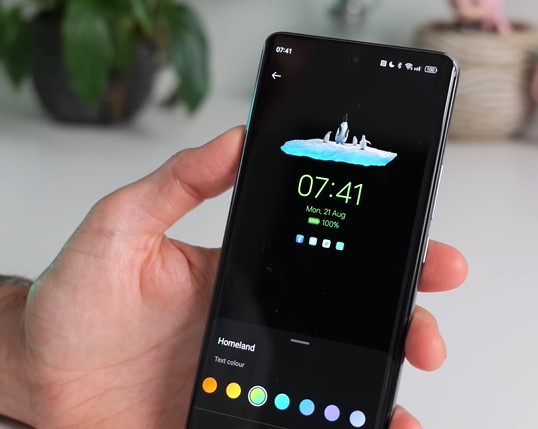Oppo Reno 10 5G a mid-range flagship that has a zoom lens and lightning-fast charging making it an intriguing option. But the question is, is it a worth to get when compared to competitors like the Pixel 7a or Samsung Galaxy A54.
Note: This article contains Amazon affiliate links. If you make a purchase through these links, I may earn a commission at no extra cost to you.
What’s in the box?

Inside the box, the Oppo Reno 10 5G smartphone itself, a sturdy 67-Watt SuperVOOC charger for rapid charging, and a Type-C USB cable for charging and data transfer. And some user manuals and warranty documents are included to help you get started and ensure warranty coverage. However, the package does not include a protective case. If concerned about safeguarding your Reno 10 from potential damage, consider purchasing a protective case separately to keep it in top condition.
Design and Build

Having used the Reno 10 as my daily driver for a few days now, I’m happy to report that it’s still in one piece, which is a promising start. Considering its mid-range mobile, it boasts an impressively sleek design. It could easily be mistaken for a flagship device, featuring an eye-catching curved design both on the back and front. The display elegantly tapers off at the edges, giving it a premium feel. The curved finish not only looks good but also feels comfortable to hold, and it’s remarkably lightweight at just 185 grams.

The Oppo Reno 10 offers two color options: ice blue or silvery gray. Oppo’s naming approach is straightforward, avoiding flashy titles. The silvery gray model I have is appealing, with a plastic frame boasting a shiny metallic appearance and maintaining a slim profile.
The camera bump on the back doesn’t protrude significantly, minimizing bulk, although there’s still a slight wobble on a flat desk surface. Constructed from glass with a frosted matte finish, the back prevents fingerprint accumulation with regular handling, reducing the need for frequent wiping.
The front is protected by a pre-installed Gorilla Glass screen protector, providing peace of mind against scratches. However, the Oppo Reno 10 5G lacks an official IP rating, so it’s not advisable to expose it to excessive moisture or water.
ColorOS 13 and Features

Transitioning to the software aspect, the Reno 10 runs on Android 13 with ColorOS layered on top. My experience with ColorOS 13 has been relatively smooth, as it doesn’t interfere too extensively with the stock Android experience. Familiar elements like the apps tray and notifications drawer can be pulled down, alongside some extra features introduced by ColorOS. These include the Shelf, which essentially offers a page filled with widgets, and robust gesture support offering standard features like one-handed mode, along with useful extras such as the ability to pull down all your desktop icons, particularly handy if you have a cluttered home screen.

On the Oppo Reno 10, ColorOS excels in customization, offering various options for always-on displays, including quirky choices like the sad penguin and polar bear, along with the sleek addition of the edge light notification feature, adding flair to your notifications.
Waking up the Reno 10 5G by pressing the power button may take a couple of seconds, but the face unlock feature provides a speedy alternative for unlocking the device. The optical in-display fingerprint sensor is generally reliable, as long as your fingers aren’t excessively wet or dry.
One standout feature of the Reno 10 is its ample storage capacity, boasting 256GB, quite generous when compared to base models of competitors like the Galaxy S23 and iPhone 14 series, which typically start at 128GB. And you can expand storage using microSD memory cards, a boon for heavy downloaders or frequent photo and video capturers providing ample room for all your digital needs.
Display

Much like its predecessor, the Reno 9, the Oppo Reno 10 boasts a splendid 6.7-inch AMOLED display, a real treat for the eyes. Featuring a full HD Plus panel with HDR 10+ support, it’s ideal for streaming platforms like Netflix, delivering crisp contrast and beautifully natural-looking visuals and colors pop with vibrancy especially when enjoying animated content. The small selfie camera cutout near the top of the screen doesn’t significantly intrude on the viewing experience.
Reno 10 can reach around 500 nits remains perfectly usable even outdoors in sunny conditions. And display automatically switches between 60Hz and 120Hz refresh rates for supported content providing a smooth and fluid viewing experience. It’s worth noting that ColorOS may occasionally slow down the system a bit, but this doesn’t seem to affect responsiveness. Despite the curved screen, the Reno 10 5G offers a comfortable grip, allowing for smooth scrolling and swiping without any issues.
Speaker
The Oppo Reno 10 features a stereo speaker setup delivering a satisfying audio experience. While clarity at maximum volume may not be impeccable, it’s undeniably loud, ensuring clear content even in noisy environments. What’s noteworthy is that the audio output is well-balanced, avoiding a heavy bias towards the bottom speaker often seen in some setups. The balanced audio contributes to an overall enjoyable sound experience.
Performance
Unlike its predecessor, the Reno 9, which relied on the dependable Qualcomm Snapdragon 778G chipset, Oppo has chosen to go with MediaTek for the Reno 10. Inside, you’ll find the Dimensity 7050 chipset, paired with eight gigabytes of RAM. In my experience over the past few days, the Reno 10 5G has generally been well-behaved, although there have been a couple of quirks.
The Reno 10 occasionally takes a few seconds to wake up, and there was one instance where I urgently needed to use the camera, but it seemed to take several taps to open the camera app. Once opened, tapping the shutter button didn’t respond as swiftly as I’d hoped, which can be frustrating in those critical moments. These performance hiccups, while not frequent, are worth noting when considering the device’s overall performance.

The performance capable of handling any game title from the Play Store and has dedicated gaming tools accessible mid-game allowing you to block notifications, adjust screen sensitivity, and capture gameplay for sharing.
Demanding titles like Genshin Impact run smoothly on lower graphics settings, but for higher visual quality, utilize the performance booster and in-game toolbar. Even then, don’t expect entirely smooth gameplay, but it remains playable. The Reno 10 may heat up during extended gaming sessions, though this doesn’t significantly impact performance, at least in my testing.
Battery Life
Oppo fits a substantial 5,000 milliampere-hour battery into the sleek chassis of Reno 10, and the battery life is exceptional. You can expect a full day’s use on a single charge, from dawn until dusk, even with significant screen-on time.
As a heavy smartphone user, often spending five to six hours a day on my device, I found that I could only bring the battery down to around 35% to 40% on a particularly intensive day, involving lots of camera use, video streaming, and background podcast streaming. This means that with more conservative use, you could comfortably stretch the battery to last for two days between charges.
Even running low on battery, there’s no need to worry, thanks to the inclusion of the 67-watt SuperVOOC fast charging. Plug it in for just a few minutes, and you’ll witness a significant boost in the battery level.
But, it’s important to note that Reno 10 does not support wireless charging, which is still relatively uncommon in this price range.
Camera Test



Oppo Reno 10 features a triple-lens configuration on the rear, and interestingly, none of these lenses are wasted on a subpar macro or depth sensor. The primary shooter boasts a 64-megapixel sensor with pixel binning capabilities, allowing you to capture at the full 64-megapixel resolution if desired.
In favorable lighting conditions, the primary camera delivers sharp, detailed photos with vibrant colors. However, when you transition indoors, you may notice an increase in graininess, reduced color vibrancy, and potential blurriness with any movement. Low-light situations can also pose challenges, but the built-in night mode helps brighten up shots, making subjects more discernible. Overall, the camera performance is solid, especially in good lighting conditions.


The second lens on the Oppo Reno 10 is a 32-megapixel portrait shooter equipped with a two-times optical zoom, allowing you to get closer to your subject without physically invading their personal space. This lens achieves the classic bokeh effect by blurring the background. If the two-times zoom feels excessive, you can switch back to the primary shooter. Like the main camera, the portrait shooter excels in well-lit outdoor settings, but indoor shots may appear somewhat flat with increased grain.
The third lens is an 8-megapixel ultra-wide-angle shooter, perfect for fitting more into your frame. It’s a reliable addition for expanding your photography horizons and capturing wider scenes. This trio of lenses offers versatility for various photography scenarios, from portraits to landscapes, giving you options to get creative with your shots.


The Reno 10 offers a variety of additional camera modes, including a Pro mode for those who want to tinker with settings like ISO, shutter speed, and white balance. It can also record video in up to 4K resolution, with the option to switch to the portrait lens for closer shots without disturbing your subject. Video quality is decent, with acceptable stabilization even when utilizing the zoom lens.
On the front, there’s a 32-megapixel selfie camera that performs similarly to the rear camera. It works well in favorable lighting conditions and can capture portrait mode shots to achieve that desirable background blur effect. The selfie camera is suitable for video chatting applications like Skype and Zoom, with clear audio pickup. For vloggers and content creators, the front camera can record videos in up to full HD resolution, providing a reliable option for creating content on the go.
Final Thought
So the Oppo Reno 10 5G may not represent a massive leap from its predecessors, but it offers a sleek design, exceptional battery life, and a few Color OS software quirks. While it may not match the performance of some other mid-range phones and lacks wireless charging, it shines with its two-times optical zoom lens, perfect for capturing distant subjects without intruding on the action. However, its camera performance in indoor and low-light conditions falls short of excellence, with the Pixel 7a outperforming in these scenarios.
The Oppo Reno 10 5G may not represent a massive leap from its predecessors, but it offers a sleek design, exceptional battery life, and a few Color OS software quirks. While it may not match the performance of some other mid-range phones and lacks wireless charging.
- Design9
- Software8
- Display8.5
- Audio7.5
- Performance8.5
- Battery Life8.5
- Camera7.5

